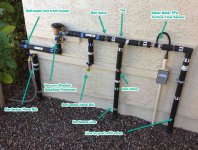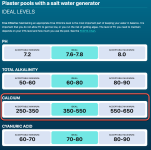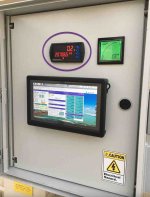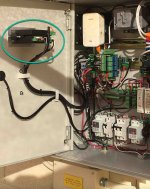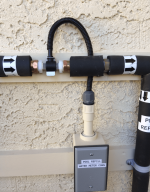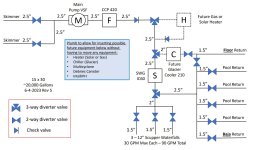@Schwimmbad
Here are my personal thoughts and experiences regarding the use of soft water for evaporation compensation (and for those that employ a DE or Sand Filter and require backwashing).
1. I use soft water to compensate for loss of water due to evaporation or water "splash-out" and I have been doing so now for 3 1/2 years.
2. When I first plumbed in a softened water line to my auto-fill leveler, my cH was approaching 800 ppm and climbing. At that time, I performed a partial drain which got it down to about 600ppm. Up until about 6 months ago, I was still using a sand filter, so I performed regular backwashes which caused the cH to decrease even further.
3. Currently, my cH is down to about
475ppm. My target is 400ppm. When it gets to that level, I plan to alternate between city (hard) water and softened water (I'll explain how in a moment). Maybe I'll rotate 2 months city and 2 months soft. I'll cross that bridge when I get there. Agree with
@Newdude. Regular cH monitoring will insure that your cH will never fall below the minimum range.
4. The cH of the Chandler municipal water supply is about
200-250ppm. Buckeye water should be about the same. Upon initial fill (muni hard water of course), maybe you could start off compensating for evaporation with hard water and let your cH climb up to about 400ppm or so (
The TFP recommended "Ideal" range is 350-550 ppm).
5. I'm running a Kinetico dual tank soft water system, so I am not really concerned with slightly increased re-generations of the softener or softener power consumption, since when one tank is regenerating the other is providing soft water. The tanks switch over automatically and as the name implies, it uses kinetic energy and not electricity for regeneration. Salt consumption for the softener increased by about 25%, after plumbing the soft water line to the pool auto refill line. A bit more salt consumption in the summer but still, it's not bad. For the house and the pool, I consume approximately 1 bag of salt per month on average.
6. Based on my experiences,
@mas985 is about right on target. Back in 2018, I performed the famous "bucket test" calculations and it came out to about 79 gallons per day. Later, I added a flow meter to the auto refill line. Last year, my flow meter reported total water usage of a little over 28,000 gallons for the year. That's about 78 gallons a day for a pool surface area of 678 square feet.
7. This is my current setup to deliver soft (or hard) water to the pool auto-fill leveler...
View attachment 505554
I'm pretty sure that your city code will require a
Vacuum Breaker Backflow Preventer in any case. I have one out at the front of the house for the hardwater line and a second one (as shown in the photo above), on the soft water line that comes from the inside house water supply.
As you can see in the photo, I have the means (through the use of ball valves), to deliver either hard water or soft water to the pool auto-fill leveler. That way, if my cH nears minimum recommend (for me that is below 400 ppm), then I can just switch over from soft water to hard water.
Hey, I hope some of this helps and good luck with your pool build.

r.
View attachment 505557


